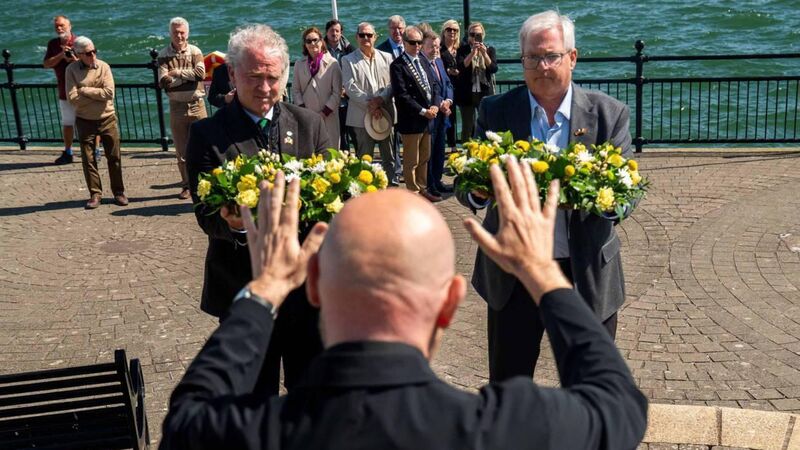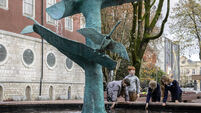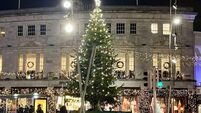John Arnold: 200 years on... remembering Cork folk who left for Canada

The sun shone down brilliantly last week when we gathered by the quayside in Cobh. A piper played as the flags of many nations fluttered in the balmy breeze. There was a fine gathering present from ‘home and away’.
Two hundred years ago to the day, in May, 1825, there was a massive throng on that same quay. It probably was a day of hugely mixed emotions as hundreds of ‘reduced farmers’ and their families boarded ships bound for Canada.
Yes they were heading for a new life in a new country - with the promise of 70 acres of land for every family - but their hearts must have been breaking.
We’ve often heard of ‘American Wakes’ held before Irish emigrants left to go to America. A wake was normally held on the death of a family member, but going to America or Canada was akin to a bereavement.
In truth, the chance of the departing person or persons ever again seeing Ireland and their family was really non-existent.
The event in Cobh was to officially commemorate what are known as ‘The Robinson Settlements’. In 1823 and again in 1825, a total of 11 ships departed from Cobh with over 2,500 immigrants on board.
It was an initiative of the English Government to help people from Ireland settle in Canada. I suppose one could say it was a great and benevolent gesture - paying for the journey to Canada, then providing land, seed, tools, blankets, and household goods, and charging just the equivalent of fourpence an acre in annual rent.
Canada was hugely underpopulated, whereas the opposite was the case here in Ireland.
The population continued to grow as we became more and more dependent on the ‘humble spud’ -with awful consequences in the 1840s.
Under the old Brehon method of inheritance, a landowner with 20 acres left his farm equally between his sons. If there were four sons, each got five acres - in a few generations there were thousands of ‘farms’ in this country of less than four acres.
In the 1820s, land agitation against landlords began to grow. Were the Robinson Settlements a handy way of getting rid of trouble-makers? We can only surmise all these things.
One thing we know is that Canadian Peter Robinson held the position of Commissioner of Crown Lands. In late 1822, the ‘scheme’ was devised - those going to Canada would be given every help to establish themselves as farmers in their new country.
Those travelling had to be under 45, many went in family groups, and tens of thousands applied to go. It was probably the local landlords, in conjunction with Robinson, who had the final say in the selection process.
The first two ships, the Hebe and the Stakesby, left the quayside in Cobh in 1823. In total, 568 immigrants were on board.
While Robinson was in charge of the ‘the nuts and bolts’ of the assisted immigration, it was the English Under Secretary for the Colonies Robert John Wilmot-Horton who was in control of the entire venture.
Horton selected the greater Blackwater Valley as the place to get the potential ‘settlers’, to set out from Cobh bound for Upper Canada. Those that went were mainly from the hinterlands of Charleville, Mitchelstown and Fermoy - basically, north Cork and south Limerick.
Many years ago, a Richard O’Meara from Canada called to visit me here at home. He was trying to trace his family tree going back to a John Mara from around here. A few years later, a Michael Hoare was here – he had Mara ancestry also.
In the 1830s, a Mara family lived here in my townland of Garryantaggart, and, with Richard and Michael, I tried to unravel the story of their family. Neither of them spoke of the Robinson Settlements.
Then, some years later, Glenn O’Meara - nephew of Richard - began to correspond with me and a new family vista opened up.
Glenn is a direct descendant of John Mara, who was on board the Stakesby. Along with his family, John Mara left Ireland for the last time on July 8, 1823, and arrived in Quebec, nearly two months later, on September 3.
It was an emotional event for Glenn and Paul Hickey, who placed two floral wreaths on the water of the quayside. In silence then, we watched as the gently lapping waves took the beautiful wreaths away, away on the surf until we could see them no more - where are they now?
The thoughts and indeed wishes of all present were surely: ‘May the vast waters of the North Atlantic never separate us from the warm fires we forever will share at the hearth of our Irish and Canadian families’.
Later, in the Heritage Centre, Francis Dwyer, who described himself as “a Canadian, a son of Ireland too”, spoke proudly of his family history, intertwining the shamrock and the maple leaf. He told us how he had met his wife and now, on this historic trip ‘home’, he poignantly brought her ashes to be scattered in the Emerald Isle.
I think I might never have heard of the Robinson Settlements but for a series of articles written by a historian friend of mine, Christy Roche.
Research is painstaking, and sometimes can yield very little, but now and then one can hit the ‘jackpot’. Myself, Pat English and Robert Barry were in Cobh that day - we had met Glenn on a visit to the Fermoy area last year. We bade farewell to him last week with plans to meet in September.
The Ballyhoura Development organisation has a packed programme running from September 15-21 - a must for anyone with even the remotest interest in this fascinating chapter in Irish history.
Another colleague of mine, Eamonn Cotter, is a dab hand at checking and double-checking everything – public records, old documents and a myriad of other sources. Telling Eamonn of our Cobh trip, he went away and in a few hours he unearthed an amazing item. The John Mara who travelled on the Stakesby (Glenn O’Meara’s ancestor) had written letters home to his brother James, one in 1823 and another the following year - and Eamonn had found them!
The 1823 letter went...
In the 1824 letter, John urges James to leave behind “the poverty and dirty misery” in Ireland.
Gradually, the Maras became Mearas and by the 1880s had added an ‘O’.
Glenn had never seen the letters and was absolutely amazed.
Here’s to the great gathering in September, and here’s to you Mr Robinson.







 App?
App?







